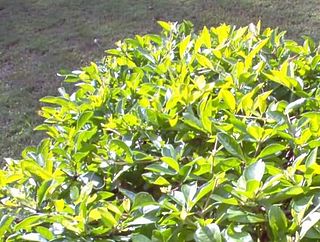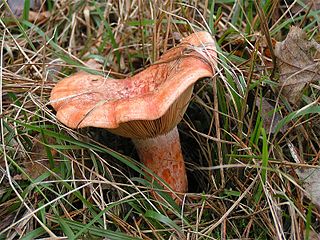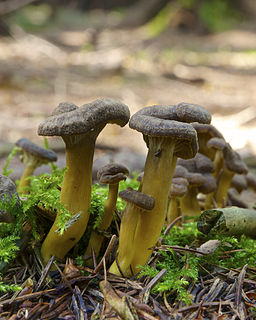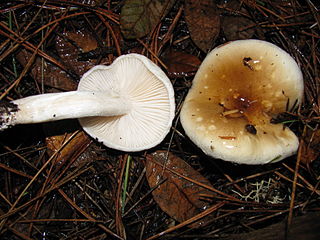
A mushroom or toadstool is the fleshy, spore-bearing fruiting body of a fungus, typically produced above ground, on soil, or on its food source.

Pruning is a horticultural, arboricultural and silvicultural practice involving the selective removal of certain parts of a plant, such as branches, buds, or roots.

In mycology, a partial veil is a temporary structure of tissue found on the fruiting bodies of some basidiomycete fungi, typically agarics. Its role is to isolate and protect the developing spore-producing surface, represented by gills or tubes, found on the lower surface of the cap. A partial veil, in contrast to a universal veil, extends from the stem surface to the cap edge. The partial veil later disintegrates, once the fruiting body has matured and the spores are ready for dispersal. It might then give rise to a stem ring, or fragments attached to the stem or cap edge. In some mushrooms, both a partial veil and a universal veil may be present.

Lactarius deliciosus, commonly known as the saffron milk cap and red pine mushroom, is one of the best known members of the large milk-cap genus Lactarius in the order Russulales. It is found in Europe and has been accidentally introduced to other countries under conifers and can be found growing in pine plantations. A fresco in the Roman town of Herculaneum appears to depict Lactarius deliciosus and is one of the earliest pieces of art to illustrate a fungus.

Paxillus involutus, commonly known as the brown roll-rim, common roll-rim is a basidiomycete fungus that is widely distributed across the Northern Hemisphere. It has been inadvertently introduced to Australia, New Zealand, South Africa, and South America, probably transported in soil with European trees. Various shades of brown in colour, the fruit body grows up to 6 cm high and has a funnel-shaped cap up to 12 cm wide with a distinctive inrolled rim and decurrent gills that may be pore-like close to the stipe. Although it has gills, it is more closely related to the pored boletes than to typical gilled mushrooms. It was first described by Pierre Bulliard in 1785, and was given its current binomial name by Elias Magnus Fries in 1838. Genetic testing suggests that Paxillus involutus may be a species complex rather than a single species.

Lactarius turpis is commonly known as the ugly milk-cap in English. It is found naturally in Europe and Siberia, and has been introduced to Australia and New Zealand. While especially associated with birch, it is also found with spruce, pine and other trees in mixed woodland.

Gymnopilus junonius is a species of mushroom in the family Cortinariaceae. Commonly known as the spectacular rustgill, this large orange mushroom is typically found growing on tree stumps, logs, or tree bases. Some subspecies of this mushroom contain the neurotoxic oligoisoprenoid gymnopilin.

Chroogomphus vinicolor, commonly known as the wine-cap Chroogomphus or the pine spike, is a species of mushroom in the family Gomphidiaceae. Found in North America and the Dominican Republic, mushrooms grow on the ground under pine trees. Fruit bodies have reddish-brown, shiny caps atop tapered stems. The gills are thick, initially pale orange before turning blackish, and extend a short way down the length of the stem. Although the mushroom is edible, and sold in local markets in Mexico, it is not highly rated. Distinguishing this species from some other similar Chroogomphus species is difficult, as their morphology is similar, and cap coloration is too variable to be a reliable characteristic. C. vinicolor is differentiated from the European C. rutilus and the North American C. ochraceus by the thickness of its cystidial walls.

Neolentinus lepideus is a basidiomycete mushroom of the genus Neolentinus, until recently also widely known as Lentinus lepideus. Common names for it include scaly sawgill, scaly lentinus and train wrecker.

The crown of a plant refers to the total of an individual plant's aboveground parts, including stems, leaves, and reproductive structures. A plant community canopy consists of one or more plant crowns growing in a given area.

Lactarius rufus is a common, medium-sized member of the mushroom genus Lactarius, whose many members are commonly known as milkcaps. Known by the common name of the rufous milkcap, or the red hot milk cap in North America. It is dark brick red in color, and grows with pine or birch trees.

Craterellus tubaeformis is an edible fungus, also known as yellowfoot, winter mushroom, or funnel chanterelle. It is mycorrhizal, forming symbiotic associations with plants, making it very challenging to cultivate. It is smaller than the golden chanterelle and has a dark brown cap with paler gills and a hollow yellow stem. C. tubaeformis tastes stronger but less fruity than the golden chanterelle. It has a very distinctive smokey, peppery taste when raw. It grows in temperate and cold parts of Northern America and Europe, including Scandinavia, Finland, Russia, and the British Isles, as well as in the Himalayas in Asia, including Assam, in the central parts of the Indian subcontinent, and in Thailand.

Lactarius glyciosmus, commonly known as the coconut scented milk cap, is a semi-edible mushroom in the genus Lactarius. Mycorrhizal, it can be found growing in soil at the base of birch trees in Europe. It is typically coloured a greyish lilac, with the sometimes hollow stem a little lighter coloured than the cap. It has crowded, decurrent gills, and smells strongly of coconuts.

Lactarius vietus is a species of fungus in the family Russulaceae, first described by Elias Magnus Fries. It produces moderately sized and brittle mushrooms, which grow on the forest floor or on rotting wood. The flattened-convex cap can vary in shape, sometimes forming the shape of a wide funnel. It is typically grey, but the colour varies. The species has crowded, light-coloured gills, which produce white milk. The spore print is typically whitish, but also varies considerably. The mushrooms typically have a strong, acrid taste and have been described as inedible, but other authors have described them as consumable after boiling. L. vietus feeds by forming an ectomycorrhizal relationship with surrounding trees, and it favours birch. It grows in autumn months and is fairly common in Europe, North America and eastern Asia.

Water sprouts or water shoots are shoots that arise from the trunk of a tree or from branches that are several years old, from latent buds. The latent buds might be visible on the bark of the tree, or submerged under the bark as epicormic buds. They are sometimes called suckers, although that term is more correctly applied to shoots that arise from below ground, from the roots, and a distance from the trunk. Vigorous upright water sprouts often develop in response to damage or pruning.

Suillus brevipes is a species of fungus in the family Suillaceae. First described by American mycologists in the late 19th century, it is commonly known as the stubby-stalk or the short-stemmed slippery Jack. The fruit bodies (mushrooms) produced by the fungus are characterized by a chocolate to reddish-brown cap covered with a sticky layer of slime, and a short whitish stipe that has neither a partial veil nor prominent, colored glandular dots. The cap can reach a diameter of about 10 cm, while the stipe is up to 6 cm long and 2 cm thick. Like other bolete mushrooms, S. brevipes produces spores in a vertically arranged layer of spongy tubes with openings that form a layer of small yellowish pores on the underside of the cap.

Hygrophorus agathosmus, commonly known as the gray almond waxy cap or the almond woodwax, is a species of fungus in the family Hygrophoraceae. It was first described by Elias Magnus Fries in 1815; Fries gave it its current name in 1838. A widespread species, it is distributed in the United States, Europe, Africa, and India, and is found growing under spruce and pine in mixed forests. The fruit bodies are characterized by a light grayish cap that measures up to 8 cm (3.1 in) in diameter, waxy gills, a dry stem, and the distinct odor of bitter almonds. An edible but bland-tasting mushroom, extracts of the fruit bodies have been shown in laboratory tests to have antimicrobial activity against various bacteria that are pathogenic to humans.

Mycena maculata, commonly known as the reddish-spotted Mycena, is a species of fungus in the family Mycenaceae. The fruit bodies, or mushrooms, have conic to bell-shaped to convex caps that are initially dark brown but fade to brownish-gray when young, reaching diameters of up to 4 cm. They are typically wrinkled or somewhat grooved, and have reddish-brown spots in age, or after being cut or bruised. The whitish to pale gray gills also become spotted reddish-brown as they mature. The stem, up to 8 cm (3 in) long and covered with whitish hairs at its base, can also develop reddish stains. The mycelium of M. maculata has bioluminescent properties. The saprobic fungus is found in Europe and North America, where it grows in groups or clusters on the rotting wood of both hardwoods and conifers. The edibility of the fungus is unknown. Although the species is known for, and named after its propensity to stain reddish, occasionally these stains do not appear, making it virtually indistinguishable from M. galericulata.

Hygrophorus bakerensis, commonly known as the Mt. Baker waxy cap, the brown almond waxy cap or the tawny almond waxy cap, is a species of fungus in the family Hygrophoraceae. It is characterized by its medium to large, relatively slender-statured fruit bodies with an almond odor, and growth often on or near rotting conifer wood. The slimy cap is brown in the center and cream to white near its curved edges. The gills and the stem are white, and in moist environments are often covered with droplets of a translucent liquid. The mushroom is known only from the United States, where it is common in coniferous forests throughout the Pacific Northwest. It was initially collected in Washington State on Mount Baker, a volcano. Although edible, the mushroom is not considered to be of high quality.

Cortinarius vanduzerensis is a species of mushroom in the family Cortinariaceae. Described as new to science in 1972, it is known only from the Pacific Northwest region of North America, where it grows under conifers such as spruce, hemlock, and Douglas-fir. The fruit bodies of the fungus, or mushrooms, have a slimy dark chestnut-brown cap that becomes deeply radially grooved or corrugated in maturity, and reaches diameters of up to 8 cm. The gills on the underside of the cap are initially pinkish-buff before becoming pale brown when the spores mature. The stem is lavender, measuring 10–18 cm (4–7 in) long and 1–2 cm thick. The mushroom produces a rusty-brown spore print, with individual spores measuring 12–14 by 7–8 micrometers. The edibility of the mushroom has not been determined, and it has been described as "much too slippery to be of value".




















